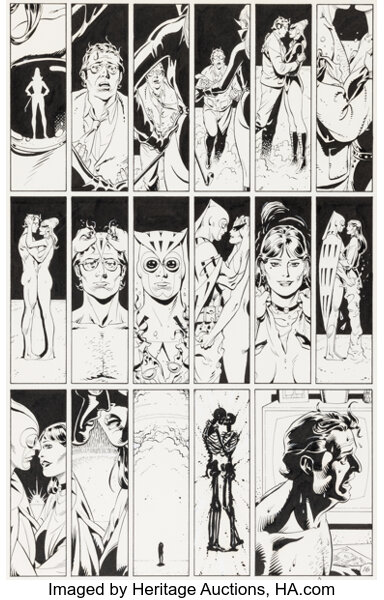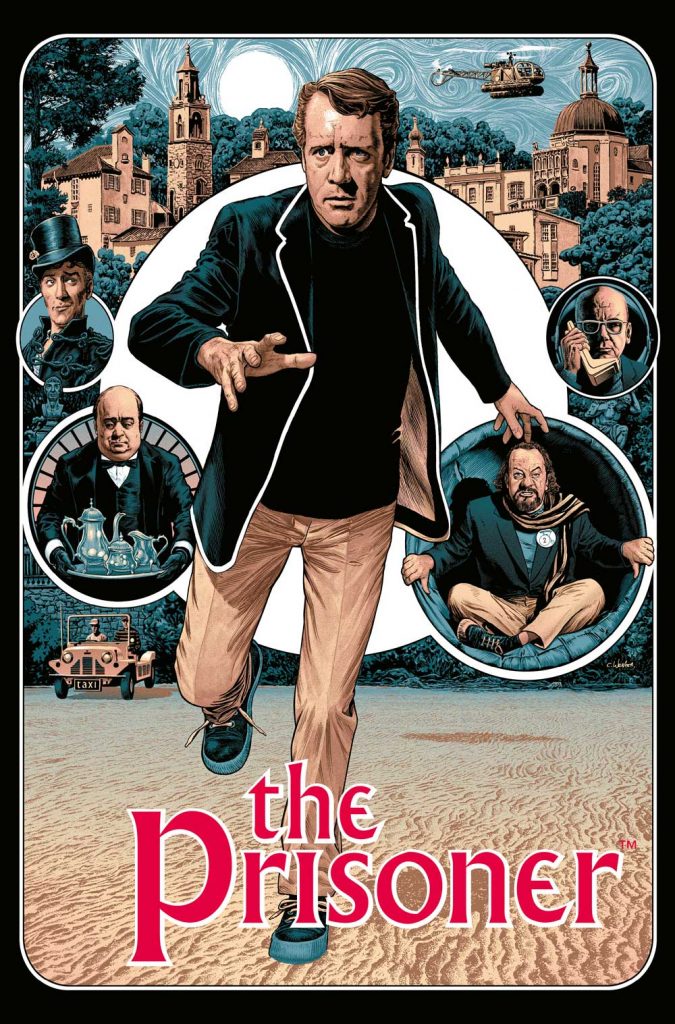(1) SFWA SECRETARY CANDIDATE WITHDRAWS. The Science Fiction and Fantasy Writers Association will open voting on October 9 for candidates to complete the terms of the president and secretary. SFWA today notified members the initial candidate for Secretary, Matthew Reardon aka JRH Lawless, has withdrawn from the race. There is a write-in for the position, Steven D. Brewer.
The office of President was vacated by the resignation of SFWA President Jeffe Kennedy on August 1. And when Interim President Chelsea Mueller resigned on August 15, Secretary Anthony W. Eichenlaub moved up to take her place.
Those chosen in the Special Election will serve the remainder of the current terms (until June 30, 2025).
(2) JUDY-LYNN DEL REY TRIBUTE ON PBS. The Renegades episode “Judy-Lynn del Rey: The Galaxy Gal” premiered October 1 on PBS and the 12-minute video can be viewed at the link. The episode features interviews with: Shelly Shapiro, an editor and Judy-Lynn del Rey’s former assistant; Stephen Donaldson; filmmaker and dwarfism historian Aubrey Smalls; Toni Weisskopf; Lois McMaster Bujold; and Dennis Wise, Professor at the University of Arizona and a Del Rey scholar.
About the Episode
Judy-Lynn del Rey (1943-1986) was a New York sci-fi and fantasy editor and a woman with dwarfism who revolutionized the world of sci-fi editing with books from luminaries such as Arthur C. Clarke, Isaac Asimov, and Philip K. Dick.
After studying literature at Hunter College, she began her career in 1965 at the digest-size magazine Galaxy Science Fiction as an Office Assistant, rising up the ranks as Associate Editor in just four years. Following her numerous science fiction bestsellers for Ballantine Books, she started her own imprint, Del Rey Books, and brought along her husband Lester del Rey to revitalize the Ballantine science fiction publishing program. Between 1977 and 1990, Del Rey Books was so dominant on the science fiction and fantasy market that they had 65 different titles reach a bestseller list. Del Rey brought us many of the classic sci-fi greats and was instrumental in obtaining the rights to publish novels based on George Lucas’s “Star Wars,” selling 4.5 million copies months before the first movie was even released. Del Rey Books continues to be a publishing leader in science fiction to this day.
Renegades: Judy-Lynn del Rey explores the life and legacy of Judy-Lynn del Rey and the overarching impact of science fiction on societal norms: its ability to shape collective imagination, foster empathy and understanding, and reconfigure cultural thinking towards disability. People with disabilities, as with most historically targeted communities, are often combating inaccurate, harmful narratives about themselves….

(3) WEIRD TAXONOMY. Clayton Purdom tells LA Review of Books readers that there is such a thing as “Weird Nonfiction”.
…I call it weird nonfiction: creative work that presents itself as journalism or nonfiction but introduces fictional elements with the intention of upsetting, disturbing, or confusing the audience. Works that are about the real world or some subject within it but also question their container or their ability to be about that thing—or which veer from the thing at hand toward the cosmic, horrifying, or absurd. Sometimes it is as if the element of unreality is chasing the author through the piece.
Early examples include the essays and essay-like fictions of Jorge Luis Borges, Orson Welles’s exasperated, exuberant F for Fake (1973), and of course Marker’s otherworldly documentaries….
There are 20 things the author “knows for sure” about “weird nonfiction”. Here’s number one.
…Let’s try something different. More breaks, more air. Here are some things I know for sure about weird nonfiction:
1. The earliest example is Orson Welles’s 1938 radio play “The War of the Worlds,” which famously inspired widespread real-world panic. When one broadcaster attempted to assure his listeners that there was no actual alien invasion, he was accused of being part of the conspiracy. Weird nonfiction is an infection….
(4) PRH PUSHING BACK AGAINST BOOK BANS. “Rosalie Stewart is the anti–book banning public policy manager at Penguin Random House” – Slate provides an introduction.
While it’s not unusual for other industries to dedicate staff to influencing or changing public policy, it’s virtually unheard of in the relatively sleepy world of book publishing. Rosalie Stewart, however, has just been hired as Penguin Random House’s senior public policy manager, a new position that will fight the recent explosion in book-banning campaigns at schools and public libraries. At present, for example, officials in Texas and Iowa have attempted to argue that the book collections held by schools and libraries constitute “government speech” and are therefore not protected by the First Amendment. This bid to redefine the nature of public libraries was rejected by the 8th U.S. Circuit Court of Appeals in Iowa, but for Texas, the matter is being weighed by the notorious extremists on the “rogue” 5th Circuit. I spoke with Stewart recently about the battle before her….
… There have been two book-banning reports recently from the ALA and PEN America. The first said that book challenges are slowing down, and the second said that banning attempts have ramped up. Could you explain why there would be that difference?
My colleagues—my former colleagues, I should say—at ALA are very good at what they do, and they’re very smart. As a professional association, they just have a different focus in terms of what they’re counting. They’re focused on a very specific definition of a “book ban.” They only count book removals. But we know that this censorship is playing itself out in different ways. Not only are books being challenged, removed, and then put back on the shelf, but there is soft censorship. There’s a chilling effect in terms of the books that people are buying and teaching. I think that PEN America’s definition is a little more expansive and draws on a wider variety of sources. Censorship is not going down. Book banning is not fading away. That’s not what we’re hearing from people out there. That’s a major challenge: How do we fight back against this on such a diffuse battlefield? It’s happening at the state legislatures; it’s happening at the school boards; and it’s happening at the agency level….
(4) PERHAPS YOU MIGHT TRY THE SOUP. [Item by James Bacon.] The first issue of a new zine emanating from the “North side inner-city gentrified Dublin catlands” entitled Perhaps you might try the Soup is now available to download at the link.
Sole creator Pesto Jaguar has brought together an eclectic selection building on artistic experiences through other media and outlets. It is a very unusual zine, although an off the wall approach is not new, yet at the moment this feels different, but a mix of artists expression, satire, photographic imagery, inspired by comic culture, unorthodox yet authentic in an effort to share a set of unusual images that appeal to Pesto Jaguar and random thoughts.
Pesto Jaguar can be found on Mastodon.
Details on Pesto are thin! It’s unclear if they are just a cat prancing on a keyboard filled with catnip or a cat person who digs Pasta, Electronic Music and Comics!

(6) THIS HAPPENS WHEN SURPLUSAGE HAS NOT BEEN ESCHEWED. Muse from the Orb kicks the pith out of “Late Stage RINGS OF POWER”.
…They say God stays in heaven because He fears what He’s created, and to that I say, cool. Two seasons of The Rings of Power have convinced me God should stay out of our business, actually; the people who write Rings of Power in a windowless conference room at Amazon can take it from here. As the inevitable corporate singularity spreads toward the horizon, and our human shells are hooked up to an endless feed of shows like this, I think that we could stand to marvel more at these vast images we have been given. My roommate asked, “Are the dwarves digging down to get to sunlight?” They were.
I’ve decided that we can’t judge Rings of Power on a human scale; perhaps not even on the scale of the aforementioned God. As a piece of art, it’s far too baffling. The deeper you stare, the more it starts to feel like some non-Euclidean artifact from a Lovecraft story staring back at you. What does this dialogue mean? Why did they switch to iambic pentameter for this speech? He’s just called “The Dark Wizard”? Last season, when Galadriel’s brother Finrod turned to her in the very first episode and said
“Do you know why a ship floats and a stone cannot? Because the stone sees only downward. The darkness of the water is vast and irresistible. The ship feels the darkness as well, striving moment by moment to master her and pull her under. But the ship has a secret. For unlike the stone, her gaze is not downward but up. Fixed upon the light that guides her, whispering of grander things than darkness ever knew”
my soul left my body and floated awhile against the border of some tessellated realm as far beyond our comprehension as computer circuits are to ants’. You know how inmates trapped in solitary confinement start to lose their notions of reality the longer they’re alone? Watching Rings of Power feels a bit like that. You’re witnessing a story that’s not actually series of human interactions but a single block of inorganic text, ventriloquized by humans who seem less real with every minute that passes. After binging a few episodes, one’s sense of place and time begins to slip….
(7) UNMENTIONABLE. The movie Coraline apparently made a lot of money this summer and will make some more on Halloween: “’Coraline’ Returns to Theaters for Halloween After Summer Rerelease”. You might not be surprised that the Variety article doesn’t contain Neil Gaiman’s name. For reasons.
… The beloved, stop-motion animated film from 2009 will return on Halloween for a limited-time engagement in newly remastered 3D and 2D formats.
If you feel like you just saw “Coraline” back in theaters, it’s not deja vu — you’re right. The film just had a successful summer rerelease for its 15th anniversary, where it made $53 million globally. Henry Selick’s film now stands at a lifetime haul of $185.7 million worldwide and is the highest-grossing stop-motion film in the U.S. It’s also the highest-grossing rerelease in the U.S. in the past 10 years and the highest-grossing of Fathom’s 20-year history. Attendees on Halloween will also get a sneak peek of Laika’s upcoming film “Wildwood.”…
(8) BARELY, I TELL YOU. “‘We were only slightly influenced by the Cantina music’: the underworld sounds of Star Wars Outlaws” – so they tell the Guardian.
Have you ever thought what walking into a sweaty, dusty club on one of Star Wars’ desert planets would sound like? About what plays on the radios in the casinos on those Las Vegas-like planets? What do the merchants and miscreants of Tatooine listen to when they’re not working the moisture farms or fending off Tusken Raiders? Pondering questions like that has been Cody Matthew Johnson’s life for the past few years. The composer and artist has flirted with video game music before, with credits on Devil May Cry, Resident Evil, Bayonetta, and the cult indie Kurosawa-inspired side-scroller, Trek to Yomi. But for Ubisoft’s Star Wars Outlaws, he was tasked with making music for its seedy criminal underbelly.
(9) MAKANA YAMAMOTO Q&A. In The Bookeller: “Author Interviews – Makana Yamamoto. ‘Writing about my identity is a political statement’”.
“It’s ‘Ocean’s Eight’, but everybody’s a lesbian and it’s in space,” says Makana Yamamoto over video call from their home in Boston, Massachusetts, of their début novel Hammajang Luck. “That’s the joke answer. If I had to condense it down, it would be a heist novel about family, about home, culture and coming back home.”…
…They continued: “I had a lot of fear about it. I really wanted to do right by my community.” Début author Yamamoto is māhū, a Hawaiian term for people who embody the female and male spirit. Even if the book did not begin as a “political statement” about the Hawaiian diaspora, for Yamamoto the very act of writing is charged. “My identity is politicised. Even if I don’t want to be politicised, it’s just the nature of existing in this world as someone who is non-binary, who is māhū, who is not white, who is a lesbian. Writing about my identity is a political statement even if I don’t want it to be.”…
(10) TODAY’S BIRTHDAY.
[Written by Cat Eldridge.]
Born October 4, 1923 – Charlton Heston. (Died 2008.) For the late 1960s and into the 1970’s, Charlton Heston was the face of SF cinema in a way that I think in terms of ubiquity across multiple movies and subgenres is matched only by Jeff Goldblum in this modern era. If there was a SFF movie to be made, Heston was likely to be in it. Planet of the Apes, and its sequel Beneath the Planet of the Apes. The Omega Man. The Three and Four Musketeers, as the gold standard Cardinal Richelieu. Earthquake. And of course, perhaps the most iconic of these, Soylent Green. An ending which spawned a thousand memes, his hardbitten cop in an overcrowded New York City is a strength of character and role that is overshadowed by the even better Edward G Robinson in his last performance.
And if you wanted to branch a bit out of genre, there are always his historicals – Ben Hur, El Cid, 55 Days at Peking, The Ten Commandments, Khartoum, and Julius Caesar. I may have been violently opposed to his politics, but the man’s ability and charisma on screen remains for me, unquestioned. Even in the absolutely terrible movie Solar Crisis, which no one should watch for fear of losing SAN points, he is watchable in it, whenever he is on the screen.
Note: I picked a photo of him in Tombstone, where admittedly he only appeared in a handful of scenes as the famed rancher Henry Hooker, but oh wasn’t he magnificent!

(11) COMICS SECTION.
- Brewster Rockit displays a linguistically adaptable directory.
- The Argyle Sweater may or may not have a brain on board.
- Jerry King hears complaints about delivery times.
- Macanudo says reading choices are important.
- Book banning and Fahrenheit 451 figure in the two latest installments of Crankshaft: Crankshaft for 10/3/2024 and Crankshaft for 10/4/2024.
(12) WASCALLY WECRUIT. Heritage Auction’s October 18 – 22 The Art of Anime and Everything Cool…Volume V Signature® Auction, running October 18-22, includes such exotic treasures as Bugs Bunny’s WWII Marine Corps service record!
“Bugs Bunny RARE US Marine Corp Service-Record Book (Warner | Lot #17117” (Warner Brothers, 1942). In the ending for the 1943 cartoon Super-Rabbit, Bugs Bunny states he has some “important work to do” and marches off in a Marine uniform towards “Tokyo, Berlin, and Points East,” according to a sign he passes. With that in mind, here’s proof of his “enlistment” – an official Marine Corps Service-Record booklet numbered 000386 for “Bunny, Bugs” with the rank of Private, and below that, Sergeant. The booklet, specially prepared by the Leon Schlesinger Studio, is rubber-stamped “Sep 1 1942” and his date of birth is noted inside as April 1, 1938; the recruiting officer is Lt. Col. Newton B. Barkly from Dallas, Texas. Lt. Col. Barkely was a big cartoon fan and Bugs Bunny was his favorite; he personally contacted Schlesinger requesting art for his Marine unit, and this booklet is one of several things sent from Schlesinger’s studio. There’s a “photo” of Bugs holding a carrot on the inside front cover of this 4.125″ x 10″ tan-cover booklet. On the inside-back cover, the rabbit’s specialties are “Heckling and Wisecracking” while his favorite hobby is “heckling Elmer Fudd.” There are fingerprints but noted as “with gloves on.” Bugs really was officially inducted into the Corps as an official mascot, issued dogtags, and finally discharged at the end of World War II as a Master Sergeant. Wow! This museum-quality item has been kept with Lt. Col. Barkley’s family all this time and is fresh to the marketplace; there’s not another one in existence. Condition is Very Good with minor handling wear.

(13) NINTENDO MUSEUM. “Former Nintendo factory in Kyoto opens as nostalgia-fuelled gaming museum” and the Guardian peeks inside.
Traditionally, visitors to Kyoto in October come for momijigari, the turning of the autumn leaves in the city’s picturesque parks. This autumn, however, there is a new draw: a Nintendo museum.
The new attraction, which opens on Wednesday, is best described as a chapel of video game nostalgia. Upstairs, Nintendo’s many video game consoles, from 1983’s Famicom through 1996’s Nintendo 64 to 2017’s Switch, are displayed reverently alongside their most famous games. On the back wall, visitors can also peer at toys, playing cards and other artefacts from the Japanese company’s pre-video-game history, stretching back to its founding as a hanafuda playing card manufacturer in 1889. Downstairs, there are interactive exhibits with comically gigantic controllers and floor-projected playing cards….
… Situated on the site of the video game company’s old manufacturing plant in Uji, a 20-minute train ride south of central Kyoto, the museum is expected to welcome up to 2,000 people a day. Tickets – which are allocated via a lottery system and cost 3,300 yen (£17) for an adult – are sold out three months in advance. When it opened in 1969, Nintendo’s Uji Ogura plant manufactured the toys and playing cards that were Nintendo’s money-makers at the time. After the dawn of the video game age in the 1970s, it operated as a customer service centre for console repairs until 2016. The building is far from Kyoto’s other tourist attractions: the suburban town surrounding it has been renovating its train station, preparing for a flood of visitors in Mario hats….
… Visitors are given 10 virtual coins per visit, used to spend on the interactive exhibits. An adjacent hanafuda workshop guides guests through making their own Japanese playing cards, above a cafe that serves custom burgers. Given Nintendo’s notorious secrecy about its creative process – and corporate secrets – it is perhaps unsurprising that there is no insight into how any of the games or consoles on display were made, or who played a part in their development. Only a small display of factory prototype controllers give the briefest peek behind the curtain….
(14) BASS ACKWARDS? Futurism says a “Weird New Quantum Experiment Sounds Suspiciously Like Time Travel”.
…But quantum physicists, who pride themselves on staring into the abyss and gleaning its spooky secrets, have just discovered another baffling phenomenon to make your mind melt: “negative time.”
As detailed in a yet-to-be-peer-reviewed study covered by Scientific American, a team of researchers say they’ve observed photons exhibiting this bizarre temporal behavior as the result of what’s known as atomic excitation.
What essentially happened, as SciAm explains, is that when the photons were beamed into a cloud of atoms, they appeared to exit the medium before entering it. Trust us: we’re just as confused as you are.
“A negative time delay may seem paradoxical, but what it means is that if you built a ‘quantum’ clock to measure how much time atoms are spending in the excited state, the clock hand would, under certain circumstances, move backward rather than forward,” Josiah Sinclair from the University of Toronto, whose early experiments formed the foundation of the study, but wasn’t directly involved, told the magazine….
(15) LET’S TREAD BOLDLY. [Item by SF Concatenation’s Jonathan Cowie.] Now, way back when (shhh 1970s) when I joined fandom there was a lot of sneering in some quarters of fandom at Trekkies and Trekkers, but I must admit to having something of a soft spot for Star Trek even if these days I find the sheer number of series a tad overwhelming. To me it is a bit of fun with occasionally some episodes having great concepts, and I was particularly delighted when the opening credits would occasionally feature a script writer who was also a novelist whose books I also enjoyed. As a scientist one has to suspend one’s disbelief and that can be more easily done if there is some brief technobabble that’s not too convoluted — I can be a forgiving soul. Of course, one can be critical. Becky Smethurst is an astrophysicist at Oxford University who has a weekly vlog, Dr. Becky. This week she looks at the science of Star Trek: The Next Generation…
In this episode of Astrophysicist reacts we’re watching Star Trek: The Next Generation Season 1 Episode 6 “Where No One Has Gone Before” to pick out the science from the fiction in this sci-fi show. We’re chatting about faster than light speed travel, warp drives, special relativity including time dilation, and the idea of negative energy.
(16) VIDEO OF THE DAY. “Not even Pitch Meeting can explain this movie,” says a commenter. Ryan George’s “Megalopolis Pitch Meeting”.
[Thanks to Kathy Sullivan, Teddy Harvia, Mike Kennedy, James Bacon, Andrew Porter, John King Tarpinian, Chris Barkley, Cat Eldridge, SF Concatenation’s Jonathan Cowie, and Steven French for some of these stories. Title credit belongs to File 770 contributing editor of the day Dan’l.]





